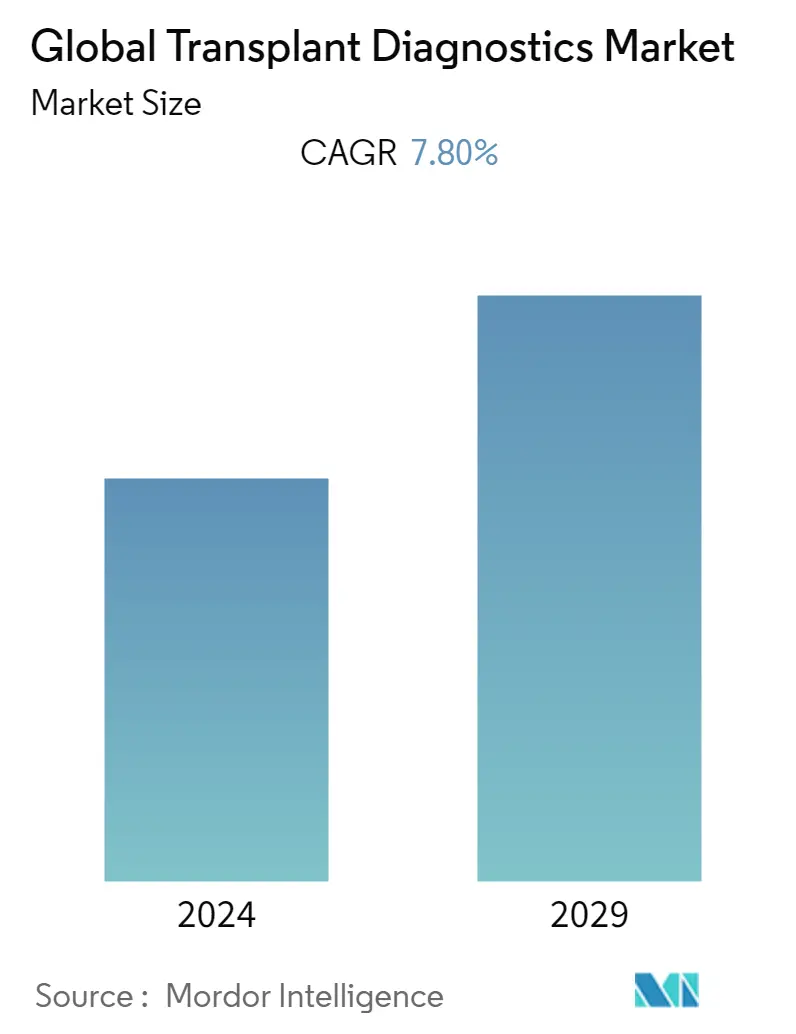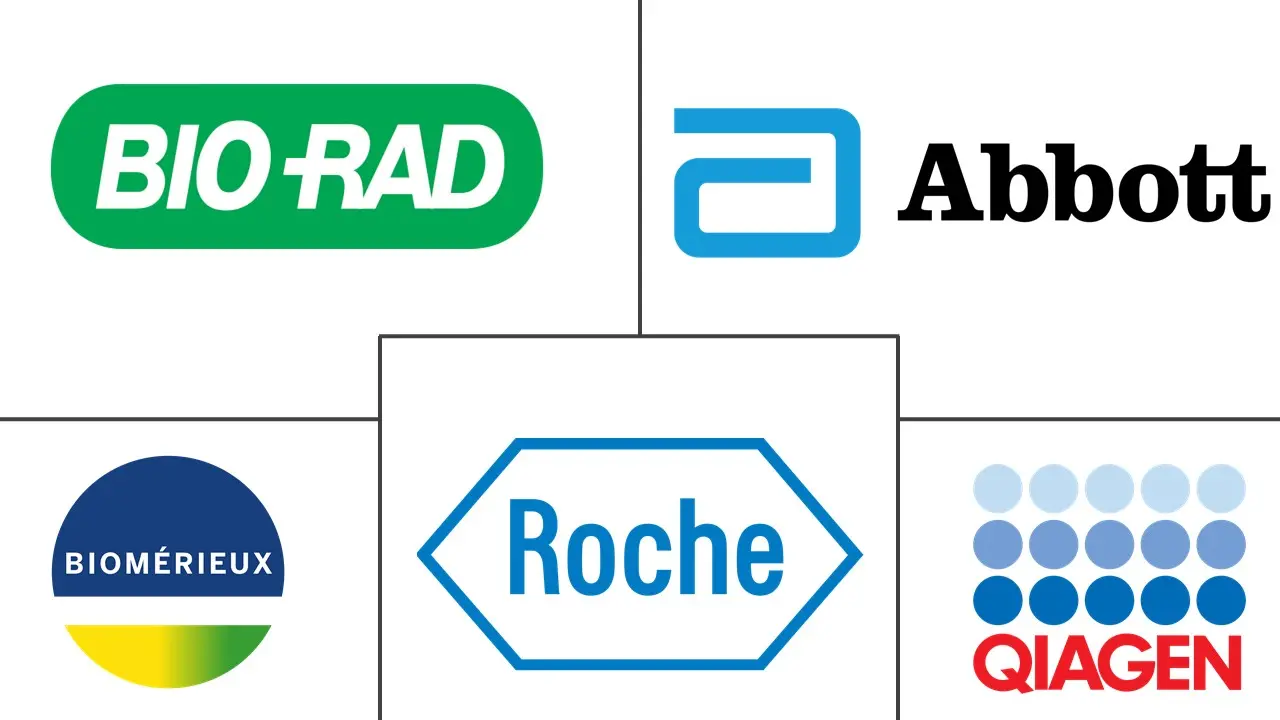Market Size of Global Transplant Diagnostics Industry

| Study Period | 2019 - 2029 |
| Base Year For Estimation | 2023 |
| Forecast Data Period | 2024 - 2029 |
| CAGR | 7.80 % |
| Fastest Growing Market | Asia Pacific |
| Largest Market | North America |
Major Players
*Disclaimer: Major Players sorted in no particular order |
Transplant Diagnostics Market Analysis
The transplant diagnostics market is poised to register a CAGR of 7.8% during the forecast period (2022-2027).
COVID-19 had a significant impact on the growth of the studied market. According to the study titled "Diagnostic Testing of COVID-19 in Solid Organ Transplantation: Current Clinical Application and Future Strategies" in October 2020, multiple elements of solid organ transplantation have been impacted by the COVID-19 pandemic, including donor and recipient appropriateness, as well as infection and transmission prevention following transplantation. During the COVID-19 pandemic, growing knowledge about the diagnostic fidelity and transmissibility of SARS-CoV-2 in immunocompromised patients continued to guide best practices for solid organ transplantation. Thus, owing to the challenges associated with transplantation amid the pandemic, COVID-19 had a pronounced impact on the growth of the market.
Transplantation is one of the preferred treatment options for many patients suffering from end-stage renal disease and undergoing chronic dialysis therapy. Also, transplantation is a viable option considered in cases associated with the heart, liver, and bone marrow. Additionally, in the past decade, diagnostics have improved significantly as companies have been committed to develop better HLA typing technologies, antibody monitoring, instruments, and software. This is gradually being used for diagnostics during the transplantation of different organs of the body.
The rising donation of organs is one of the major contributors to the growth of the studied market. According to the data published by the Association of Organ Procurement Organizations (AOPO) in January 2021, more than 12,500 people donated one or more organs in 2020, up 6% from the previous year. The number of organs donated from dead donors increased to over 36,500 in 2020, which is almost a 2% increase year over year. It also reported that in the past seven years, organs from the dead have saved more than 33,000 lives, exceeding the previous year's totals. There were also notable increases in donations after circulatory death (DCD) contributions, which totaled more than 3,000 donors in 2020. The rise in organ donation creates the need for increased transplant diagnostic testing and thus drives the growth of the market.
Moreover, the launch of new products by the market players also contributes to the growth of the market. For instance, in September 2021, Thermo Fisher Scientific added two new products to its transplant diagnostics portfolio during the American Society for Histocompatibility and Immunogenetics (ASHI) annual conference.
However, the high cost of transplants, irregular insurance and reimbursement policies, and social and ethical issues related to organ transplants may hinder the growth of the market over the forecast period.
Transplant Diagnostics Industry Segmentation
As per the scope of the report, transplant diagnostics are the tests performed prior to the relocation/transplantation of the donor organ to the recipient patient. Transplant diagnostics is necessary for the assessment of different aspects associated with a transplant during pre-, peri-, and post-transplantation. The Transplant Diagnostics Market is segmented by Technology (Molecular and Non-molecular), Product (Instrument, Reagent, and Software), Transplant Type (Solid Organ, Stem Cell, and Soft Tissue), Application (Diagnostic and Research), and Geography (North America, Europe, Asia-Pacific, Middle East and Africa, and South America). The market report also covers the estimated market sizes and trends for 17 different countries across major regions, globally. The report offers the value (in USD million) for the above segments.
| By Technology | ||||
| ||||
| Non-molecular |
| By Product | |
| Instrument | |
| Reagent | |
| Software |
| By Transplant Type | |
| Solid Organ | |
| Stem Cell | |
| Soft Tissue |
| By Application | |
| Diagnostic | |
| Research |
| Geography | ||||||||
| ||||||||
| ||||||||
| ||||||||
| ||||||||
|
Global Transplant Diagnostics Market Size Summary
The transplant diagnostics market is experiencing significant growth, driven by advancements in diagnostic technologies and an increase in organ donations. The market is characterized by a robust development of HLA typing technologies, antibody monitoring, and software, which are essential for the successful transplantation of organs such as kidneys, livers, and hearts. The COVID-19 pandemic has had a notable impact on the market, influencing practices in solid organ transplantation due to concerns about donor and recipient appropriateness and infection prevention. Despite challenges such as high transplant costs and ethical issues, the market is poised for expansion, supported by the rising number of organ donations and the introduction of new diagnostic products by key players.
North America is expected to maintain a dominant position in the transplant diagnostics market, bolstered by substantial funding for transplantation research and a high number of organ transplantations. The region benefits from well-established infrastructure, government support, and active participation from organizations promoting organ donation. The market's growth is further enhanced by initiatives from major companies introducing innovative diagnostic solutions. The competitive landscape is marked by the presence of prominent firms like Abbott Laboratories, Biomérieux SA, and Thermo Fisher Scientific Inc., which are focused on overcoming challenges related to technology and awareness. Overall, the transplant diagnostics market is set to grow, driven by technological advancements and increasing adoption of diagnostic tests.
Global Transplant Diagnostics Market Size - Table of Contents
-
1. MARKET DYNAMICS
-
1.1 Market Overview
-
1.2 Market Drivers
-
1.2.1 Growing Transplant Procedures
-
1.2.2 Technological Advacements in Transplant Diagnostics
-
1.2.3 Government and Private Collaboration into Funding Research of Target Diseases
-
-
1.3 Market Restraints
-
1.3.1 High Cost of Transplant
-
1.3.2 Insurance and Reimbursement Policies
-
1.3.3 Social and Ethical Issues Related to Organ Transplant
-
-
1.4 Porter's Five Forces Analysis
-
1.4.1 Threat of New Entrants
-
1.4.2 Bargaining Power of Buyers/Consumers
-
1.4.3 Bargaining Power of Suppliers
-
1.4.4 Threat of Substitute Products
-
1.4.5 Intensity of Competitive Rivalry
-
-
-
2. MARKET SEGMENTATION (Market Size by Value - USD million)
-
2.1 By Technology
-
2.1.1 Molecular
-
2.1.1.1 PCR-based Molecular Assays
-
2.1.1.2 Sequencing-based Molecular Assays
-
-
2.1.2 Non-molecular
-
-
2.2 By Product
-
2.2.1 Instrument
-
2.2.2 Reagent
-
2.2.3 Software
-
-
2.3 By Transplant Type
-
2.3.1 Solid Organ
-
2.3.2 Stem Cell
-
2.3.3 Soft Tissue
-
-
2.4 By Application
-
2.4.1 Diagnostic
-
2.4.2 Research
-
-
2.5 Geography
-
2.5.1 North America
-
2.5.1.1 United States
-
2.5.1.2 Canada
-
2.5.1.3 Mexico
-
-
2.5.2 Europe
-
2.5.2.1 France
-
2.5.2.2 Germany
-
2.5.2.3 United Kingdom
-
2.5.2.4 Italy
-
2.5.2.5 Spain
-
2.5.2.6 Rest of Europe
-
-
2.5.3 Asia-Pacific
-
2.5.3.1 China
-
2.5.3.2 Japan
-
2.5.3.3 India
-
2.5.3.4 Australia
-
2.5.3.5 South Korea
-
2.5.3.6 Rest of Asia-Pacific
-
-
2.5.4 Middle East and Africa
-
2.5.4.1 GCC
-
2.5.4.2 South Africa
-
2.5.4.3 Rest of Middle-East and Africa
-
-
2.5.5 South America
-
2.5.5.1 Brazil
-
2.5.5.2 Argentina
-
2.5.5.3 Rest of South America
-
-
-
Global Transplant Diagnostics Market Size FAQs
What is the current Global Transplant Diagnostics Market size?
The Global Transplant Diagnostics Market is projected to register a CAGR of 7.80% during the forecast period (2024-2029)
Who are the key players in Global Transplant Diagnostics Market?
Abbott Laboratories, Biomérieux SA, Qiagen NV, F Hoffman La Roche AG and Bio-Rad Laboratories, Inc. are the major companies operating in the Global Transplant Diagnostics Market.

